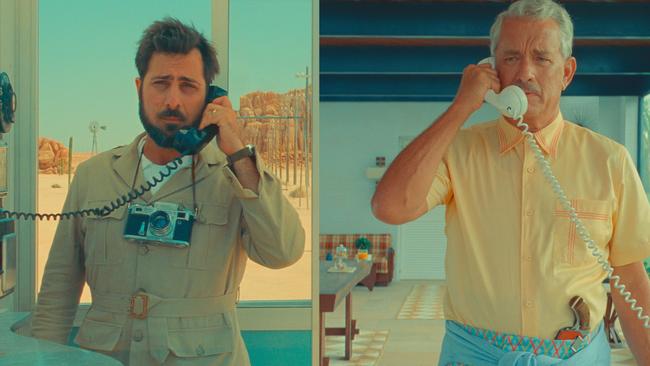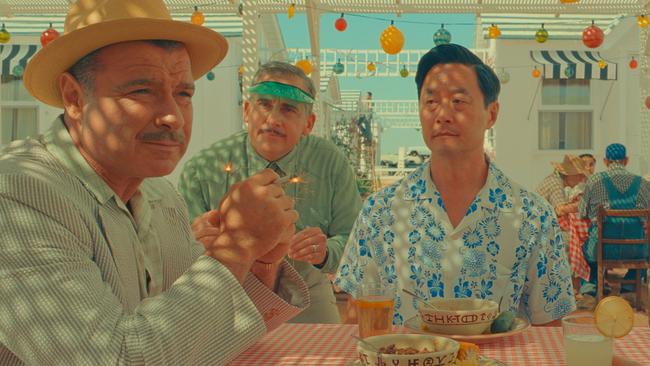Classic Wes a whimsical trip
A fictional town, a 10-room motel, a diner and a one-pump petrol station set the scene for Wes Anderson’s delightful Asteroid City.

Asteroid City (M)
In cinemas
★★★½
A train is speeding through a desert in America’s southwest. The camera shoots the train from various angles including from above as the credits roll. Does this sound familiar? I was immediately reminded of director John Sturges’s classic 1954 thriller Bad Day at Black Rock. But the next town up the line in this new film is not Black Rock but Asteroid City, and this is the latest from that master of whimsical humour Wes Anderson and the much-covered song “Last Train to San Fernando” is pounding on the soundtrack.
The train looks more like a toy than the real thing, which it is; it’s loaded down with freight – cattle, fruit of various kinds, tractors and even a nuclear warhead, emblazoned with the instruction “Do Not Detonate Without Presidential Approval”.
The population of Asteroid City is 87, so it’s hardly a thriving metropolis. It boasts a 10-room motel, a diner and a one-pump petrol station/garage. Occasionally the whole town shakes, and a mushroom cloud appears on the horizon. But nobody takes this very seriously, perhaps because it looks so artificial, as does the incomplete highway that leads nowhere. With some regularity, a pair of police cars pursue a gun-wielding felon down the main street, but nobody seems to take much notice of this either. The town’s main tourist attraction is a large crater left by a meteor many years earlier, but not many tourists are around.

The latest arrivals in town are photojournalist Augie Steenbeck (Jason Schwartzman), his geeky teenaged son Woodrow (Jake Ryan) and his three small yet preternaturally intelligent daughters who rejoice in the names of Pandora, Andromeda and Cassiopeia. As for Mrs Steenbeck – a briefly glimpsed Margot Robbie – it seems she has not survived the trip, and her remains are being transported in a Tupperware container. Augie’s first mission is to have his station wagon repaired. The town’s mechanic (Matt Dillon) is unable to achieve this, and so for the time being the Steenbeck family is stranded in Asteroid City.
They are not alone, however. Among the town’s other visitors are actor Midge Campbell (Scarlett Johansson), her daughter Dinah (Grace Edwards) and Augie’s disapproving father-in-law Stanley Zak (Tom Hanks). They are there for a Junior Stargazers convention in which Woodrow is actively participating and which is being overseen by pompous General Gibson (Jeffrey Wright).
There is also a visit from a svelte, bug-eyed alien, played by Jeff Goldblum. Rounding out the cast is Steve Carell as the overly-enthusiastic motel owner, whose bank of vending machines includes one that dispenses plots of land.
One of the things I love about Wes Anderson is his Dickensian love of names. Who could suppress a smile when Tilda Swinton crops up as Dr Hickenlooper? I also love Anderson’s whimsicality, wit and offbeat approach to narrative. When all these elements are working in harmony, the result is a masterpiece like The Grand Budapest Hotel (2014). Asteroid City is not quite up to that level, mainly because of the disconcerting framing device, filmed in black-and-white and set in a theatre where a television production of the story is being performed. An urbane Bryan Cranston narrates the show, and introduces us to the author, Conrad Earp (Edward Norton).
Asteroid City, we are assured, does not exist. The drama that unfolds is imaginary. The characters are fictional. The text is hypothetical. The events are an apocryphal fabrication.
These black-and-white scenes tend to work against the engagingly light mood and sun-drenched look of the rest of the movie (which was mostly filmed in Spain).
Despite this apparent miscalculation, the film is, for the most part, a delight. I would never miss a Wes Anderson movie, and I encourage anyone looking for something offbeat and original to go and see Asteroid City.
Chevalier (M)
In cinemas
★★★★
Joseph Bologne has been an almost forgotten figure in French history, yet he clearly played an important role in the lead-up to the French Revolution in 1789. Bologne, born on the Caribbean island of Guadalupe, was the son of a French plantation owner and a black slave. Unlike most mixed race children in his situation, Joseph seems to have been well-liked by his father, who brings him to Paris after the death of his mother.
In the French capital, despite his colour, Bologne was able to enter high society thanks to his sheer talent. He was a gifted musician and an accomplished swordsman, and even was rewarded the honorary title of Chevalier.
We first meet Bologne (Kelvin Harrison, Jr) in a powerful opening sequence set in a magnificent concert hall. Wolfgang Amadeus Mozart (Joseph Prowen) is playing to an enchanted audience and invites the young stranger to join him in a duet. The scene is unavoidably reminiscent of Amadeus (1984), partly because Milos Forman’s Oscar-winning epic was, like Chevalier, filmed in Prague.
The well-educated and well-connected Bologne is ambitious and seemingly unafraid to involve himself with society women. He embarks on a relationship with Marie-Josephine, the wife of the intimidating Marquis de Montalembert (New Zealand actor Martin Csokas). Marie-Josephine is played by Australian actor Samara Weaving, niece of Hugo, in her juiciest American role to date. Bologne also befriends the French Queen, Marie-Antoinette (Lucy Boynton).
Not very much is known about Bologne and so Stefani Robinson’s screenplay contains a fair amount of conjecture. But this was a compelling period of French history and the narrative composed for the film makes the most of the volatile backdrop.
The production, directed by Stephen Williams, is handsomely mounted, with exceptionally fine photography by Jess Hall, production design by Karen Murphy and costumes by Oliver Garcia. Impressive, too, is the music, not only the generous helpings of classical pieces heard throughout the film, but the original score written by Kris Bowers.
As the focal point in this intriguing musical drama, Harrison, Jr, who impressed as Fred Hampton in The Trial of the Chicago 7 (2020) and also made an impact playing blues legend BB King in Baz Luhrmann’s Elvis (2022), gives a powerhouse performance. Chevalier de Saint-Georges certainly seems to be among the most fascinating true-life characters of his time.






To join the conversation, please log in. Don't have an account? Register
Join the conversation, you are commenting as Logout